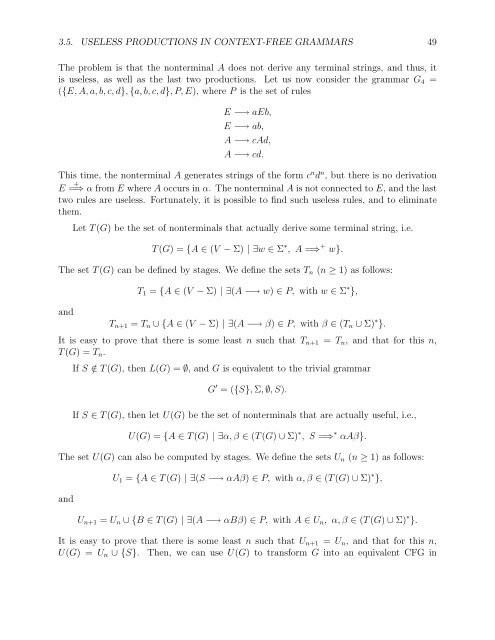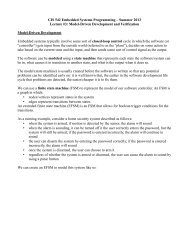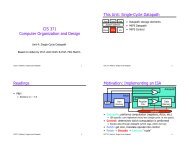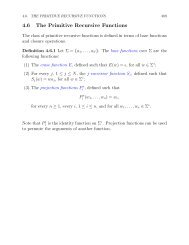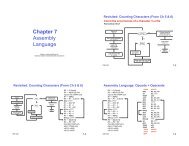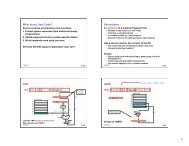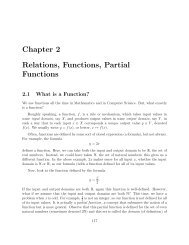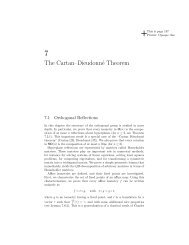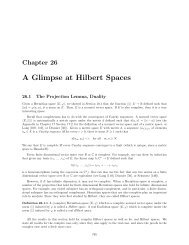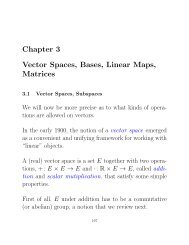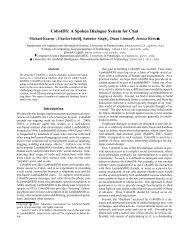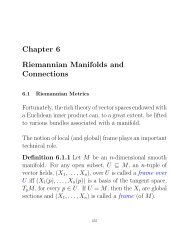Chapter 3 Context-Free Grammars, Context-Free Languages, Parse ...
Chapter 3 Context-Free Grammars, Context-Free Languages, Parse ...
Chapter 3 Context-Free Grammars, Context-Free Languages, Parse ...
You also want an ePaper? Increase the reach of your titles
YUMPU automatically turns print PDFs into web optimized ePapers that Google loves.
3.5. USELESS PRODUCTIONS IN CONTEXT-FREE GRAMMARS 49<br />
The problem is that the nonterminal A does not derive any terminal strings, and thus, it<br />
is useless, as well as the last two productions. Let us now consider the grammar G4 =<br />
({E, A, a, b, c, d}, {a, b, c, d},P,E), where P is the set of rules<br />
E −→ aEb,<br />
E −→ ab,<br />
A −→ cAd,<br />
A −→ cd.<br />
This time, the nonterminal A generates strings of the form c n d n , but there is no derivation<br />
E +<br />
=⇒ α from E where A occurs in α. The nonterminal A is not connected to E, andthelast<br />
two rules are useless. Fortunately, it is possible to find such useless rules, and to eliminate<br />
them.<br />
Let T (G) be the set of nonterminals that actually derive some terminal string, i.e.<br />
T (G) ={A ∈ (V − Σ) |∃w ∈ Σ ∗ ,A=⇒ + w}.<br />
The set T (G) can be defined by stages. We define the sets Tn (n ≥ 1) as follows:<br />
and<br />
T1 = {A ∈ (V − Σ) |∃(A −→ w) ∈ P, with w ∈ Σ ∗ },<br />
Tn+1 = Tn ∪{A ∈ (V − Σ) |∃(A −→ β) ∈ P, with β ∈ (Tn ∪ Σ) ∗ }.<br />
It is easy to prove that there is some least n such that Tn+1 = Tn, and that for this n,<br />
T (G) =Tn.<br />
If S/∈ T (G), then L(G) =∅, andGis equivalent to the trivial grammar<br />
G ′ =({S}, Σ, ∅,S).<br />
If S ∈ T (G), then let U(G) be the set of nonterminals that are actually useful, i.e.,<br />
U(G) ={A ∈ T (G) |∃α, β ∈ (T (G) ∪ Σ) ∗ ,S=⇒ ∗ αAβ}.<br />
The set U(G) can also be computed by stages. We define the sets Un (n ≥ 1) as follows:<br />
and<br />
U1 = {A ∈ T (G) |∃(S −→ αAβ) ∈ P, with α, β ∈ (T (G) ∪ Σ) ∗ },<br />
Un+1 = Un ∪{B ∈ T (G) |∃(A −→ αBβ) ∈ P, with A ∈ Un, α,β∈ (T (G) ∪ Σ) ∗ }.<br />
It is easy to prove that there is some least n such that Un+1 = Un, and that for this n,<br />
U(G) =Un ∪{S}. Then, we can use U(G) to transform G into an equivalent CFG in


